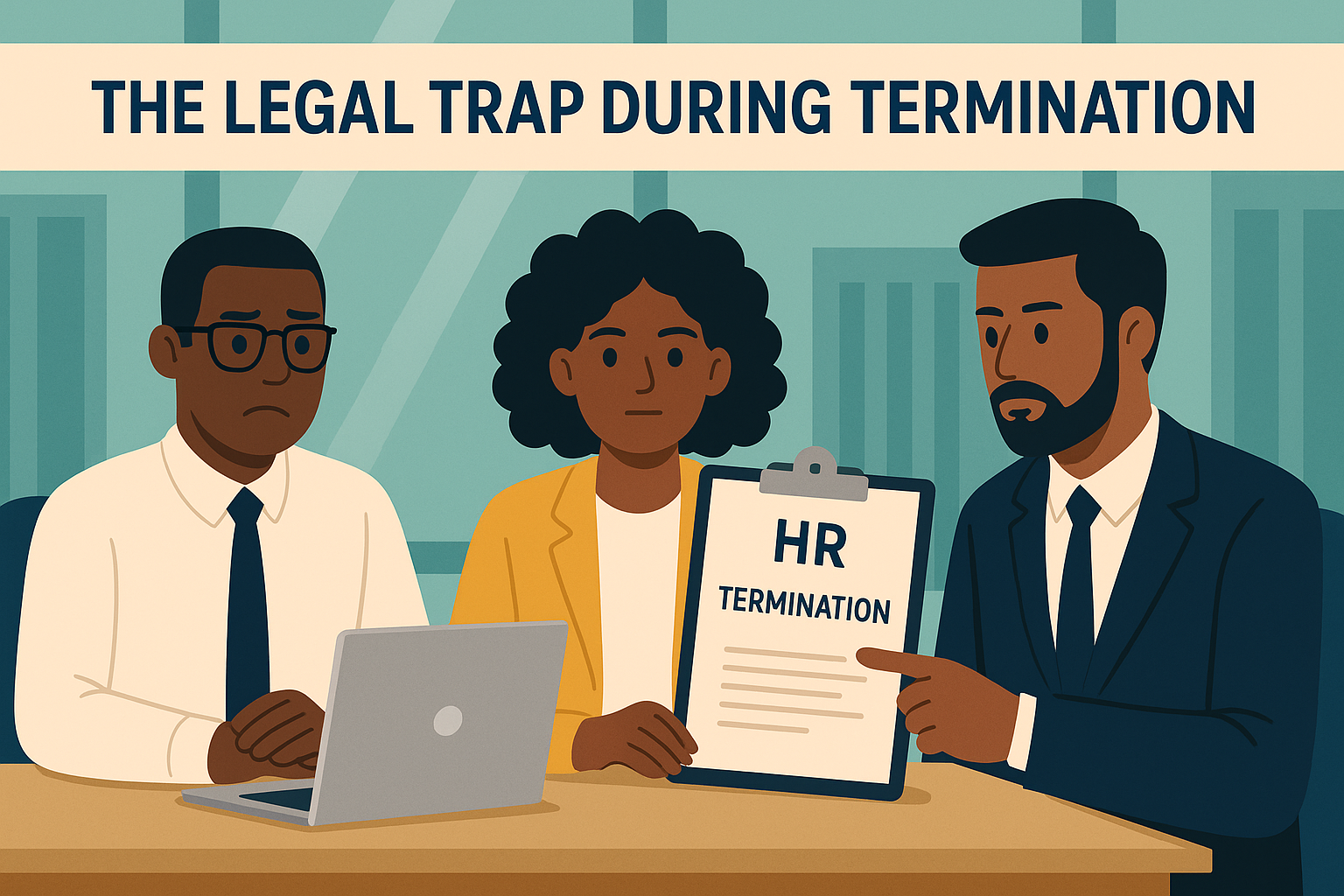The Legal Trap Most Employers Walk into During Termination
We need to talk about how terminations really play out, not in theory, not in HR handbooks but on the ground, where businesses get sued and careers get wrecked.
I’ve advised enough on both sides of the employment relationship to say this confidently; most unfair termination claims don’t start with bad intent. They start with bad process.
Let’s walk through the most common pitfalls I’ve seen employers fall into and why both employers and employees need to understand them clearly.

1. Terminating Without Cause or Without Proof of Cause
It’s illegal in Kenya to terminate employment arbitrarily. Yet many employers still dismiss staff without a solid reason they can prove.
“Lack of performance” or “disciplinary issues” may sound justifiable but if you haven’t documented the problem or followed the right steps, the law won’t be on your side.
Employees don’t have to prove much in court. If there was no process, they already have a strong case.
2. No Notice to Show Cause Letter = No Fair Warning
One of the most frequent missteps I see is skipping the Notice to Show Cause (NTSC). It’s the first formal step in the disciplinary process.
If an employee is accused of misconduct, they’re legally entitled to know what they’re accused of, in writing and given a chance to respond.
Verbal warnings don’t count. Ambiguous emails don’t count. If it’s not in writing, it’s not a valid warning under law.
3. Holding Hearings Without Giving Employees Time or Evidence
This is where many employers shoot themselves in the foot. You issue a NTSC at 10 AM and hold a disciplinary hearing at 2 PM. Or worse you reveal the evidence for the first time during the hearing.
That’s not “efficient.” It’s procedurally unfair.
An employee must be given a real chance to prepare their defence. That includes:
i. Adequate time between receiving the NTSC and the hearing
ii. Advance access to any evidence the employer intends to rely on
iii. The right to be accompanied during the hearing
Denying any of this exposes the employer to a claim for unfair dismissal no matter how strong the evidence is.

4. Failing to Keep Records or Leaving Them Unsigned
Minutes from the disciplinary hearing must be taken and preferably signed by both parties. They’re not just formalities, they’re your legal trail.
Without signed or acknowledged minutes, it becomes your word against the employee’s. And in the Employment and Labour Relations Court, that’s not a position you want to be in.
5. Verbal Termination Notices Are Legally Risky
Telling someone,
“You’re done, leave now,”
might feel final but without a written termination letter, it’s your word against theirs.
In Kenyan courts, the absence of written proof or contradictions between the NTSC, hearing minutes and final notice, can easily tip a case in the employee’s favour.
A strong process means the reason for termination must be consistent, documented and clear from start to finish.

6. The Price of Getting It Wrong
If a termination is ruled unfair, the court can award up to 12 months’ salary in damages.
This is in addition to any accrued benefits and it applies even if the employer had a valid reason but failed to follow due process.
Why? Because in Kenyan law, procedural fairness is just as important as substantive grounds.
Employees only need to prove one procedural misstep to shift the burden to the employer. From there, it’s the employer who must prove they did everything right and that’s a heavy lift without proper records.
So, What Should Employers Do?
i. Always issue a written NTSC
ii. Give employees fair time and access to prepare
iii. Hold a formal hearing and take signed minutes
iv. Provide written termination notices, with clear reasons that align with prior documentation
v. Keep records of everything and ensure they’re signed and dated
If you’re unsure whether your internal process meets legal thresholds, get a legal review before proceeding with termination. It’s cheaper than defending a court case.
And Employees Know This
If you’ve been dismissed and recognize even one of these errors in your process, you may have grounds to challenge it. But act quickly, there are statutory time limits for bringing claims. Speak to a lawyer early.
Final Thought
In Kenya, employment termination is a process. It’s not enough to be right. You have to do it right.
We help both employers and employees navigate this process with clarity, professionalism and legal discipline.
If you’re unsure, start with a consultation. One conversation now could save you months of litigation later.

.svg)



.webp)